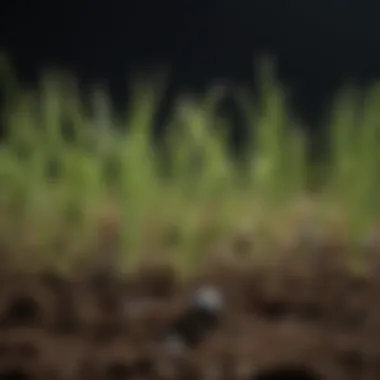Optimal Temperatures for Grass Seed Germination Explained


Intro
Understanding the factors that influence seed germination is crucial for anyone involved in gardening. Grass seeds, in particular, have specific temperature requirements that can significantly affect their growth. This article uncovers the optimal temperature ranges for various grass seed types, enabling both novice and seasoned gardeners to create favorable conditions for successful germination.
Importance of Temperature Conditions
The success of grass germination hinges on a couple of components: soil temperature and air temperature. These elements interact with the environment to either support or inhibit the growth process. Ensuring that seeds are sown at the right time, aligned with their temperature preferences, can lead to lush and healthy lawns.
Key Factors Affecting Germination
- Soil Temperature: The soil needs to reach a certain warmth to activate the seeds’ metabolic processes. Most grass seeds germinate best when soil temperatures hover between 50°F and 65°F.
- Air Temperature: While soil temperature is paramount, air temperature also plays a role. Optimal air temperatures range generally from 60°F to 75°F.
- Moisture Levels: Adequate moisture must be present to assist in breaking down the seed coat and promoting root development.
- Light: Certain grass types may have light sensitivity, which can dictate the depth at which seeds are planted.
"Proper temperature and moisture conditions are essential for unlocking the potential of grass seed germination."
To reap the benefits of successful grass growth, one should consider the specific requirements of the grass type they are planting. Understanding these varied preferences will lead to better gardening practices and optimal results.
Prolusion to Grass Seed Germination
Understanding grass seed germination is essential for anyone looking to create or maintain a healthy lawn. The germination phase is a critical period in the life cycle of grass, where environmental conditions play a significant role. Temperature is among the foremost factors that influence germination success.
Getting these conditions right can mean the difference between a lush lawn and a patchy landscape.
When grass seeds absorb water, they swell, and the seed coat softens. During this process, the embryo begins to grow, pushing through the soil. For optimal growth, a suitable temperature range is needed. Seeds that are exposed to ideal temperatures germinate faster and with a higher success rate. Conversely, if the temperature deviates from the optimal range, seed dormancy may occur, and germination could be delayed or fail entirely.
Key Considerations:
- Temperature Sensitivity: Different grass types have distinct temperature preferences, and understanding these is crucial for effective planting.
- Germination Process: The rate of germination is highly dependent on the warmth of the soil and air around the seeds. Mismatched temperatures can hinder sprouting.
- Effective Lawn Management: Homeowners and gardening enthusiasts can optimize their planting techniques by knowing the appropriate temperatures required for grass types.
By grasping the nuances of grass seed germination and its connection to temperature, readers can cultivate healthier lawns. This knowledge informs suitable planting timing, contributes to resource efficiency, and enhances overall lawn aesthetics. Understanding germination puts readers in control, allowing them to tailor their gardening practices based on scientific insights, leading to gratifying results.
Understanding the Role of Temperature
Temperature plays a crucial role in the germination of grass seeds. Understanding its significance helps gardeners and homeowners choose the right moment and conditions for seeding, which ultimately influences the success of lawn establishment.
Importance of Temperature for Seed Life Cycle
Temperature affects the entire life cycle of seeds. It determines when seeds break dormancy and begin to germinate. Seeds have a specific range of temperatures in which they thrive. If the temperature is too low or too high, it can hinder or even prevent germination. This process is essential for growth, as each stage from germination to maturity relies on consistently optimal conditions.
The physiological processes inside seeds are temperature-dependent. Proper temperatures activate enzymes needed for germination, while extreme temperatures can denature proteins, rendering seeds incapable of sprouting. Hence, striking the right balance is crucial.
How Temperature Affects Germination Rates
Germination rates are sensitive to temperature fluctuations. Warm temperatures usually speed up these rates, but only to an extent. Each grass type has its own preferred temperature range. Grass seeds can be classified primarily into cool-season and warm-season types, each responding decisively to temperature. For instance, cool-season grasses germinate best when temperatures are between 50°F and 65°F (10°C to 18°C). In contrast, warm-season varieties prefer temperatures from 70°F to 90°F (21°C to 32°C).
A temperature outside these ranges can lead to significant delays in the germination process. Additionally, consistent temperatures lead to uniform germination, which is favorable for creating dense, lush lawns. Conversely, inconsistent temperature patterns can result in uneven growth and patchy lawns, as different seeds germinate at various rates.
"Understanding how temperature impacts grass seed germination sets the foundation for effective lawn management, allowing for healthier grass and better aesthetics."
In summary, temperature is part of the intricate relationship governing plant development. It is vital for optimizing germination rates, leading to robust grass growth and a successful gardening endeavor.
Soil vs. Air Temperature
Temperature plays a critical role in the germination and overall viability of grass seeds. To ensure a successful planting experience, it is essential to distinguish between soil temperature and air temperature. Both are influential, but they can behave differently, affecting the grass seed germination process in distinct ways. Understanding these differences is vital for homeowners and gardeners aiming to optimize their planting strategies.


Defining Soil Temperature
Soil temperature is the measure of warmth within the soil environment, generally assessed at the depth where grass seeds are planted. This temperature is crucial because it influences biochemical processes that occur during seed germination. Typically, soil temperature is generally more stable than air temperature, which can fluctuate widely throughout the day and night. Measuring soil temperature can be done using simple tools like a soil thermometer or more sophisticated devices designed for monitoring soil conditions.
The optimal soil temperature for most grass seeds often lies between 50°F and 65°F (10°C to 18°C) for cool-season grasses and 70°F to 85°F (21°C to 29°C) for warm-season varieties. When soil temperatures are too low, seeds may remain dormant. Conversely, excessively high temperatures can lead to seed damage and inhibit proper growth.
Measuring Air Temperature
Air temperature is the temperature of the atmosphere surrounding the grass seed planting area. Measuring air temperature can be relatively straightforward, using standard thermometers or digital weather stations. Air temperature affects the rate of evaporation and moisture content in the soil, both of which are critical for germination success.
Air temperatures that fall within the ideal ranges for grass seeds will contribute to a leaner growing environment. As air temperature rises, it can enhance the heating of the soil, influencing seed germination indirectly. This highlights the need to monitor both soil and air temperatures to ensure the best outcomes during the planting season.
Interplay Between Soil and Air Temperature
The relationship between soil and air temperatures is dynamic and can significantly influence grass seed germination. Warm air can warm the soil, promoting faster seed activation, but this can also depend on moisture levels. Too high soil temperature, driven by warm air, can lead to unfavorable conditions, resulting in stress for the seeds.
Understanding the interplay between these two types of temperature is beneficial for gardeners. A simple rule of thumb is to monitor both environments concurrently. Even if air temperatures are warm, if the soil is still cool, there may be delays in germination.
"Monitoring both soil and air temperatures ensures a balanced approach to seed germination and promotes healthy grass growth."
This interplay emphasizes the importance of using comprehensive measuring strategies that take both aspects into account. By balancing these temperatures, gardeners can create an optimal environment for their grass seeds.
Ideal Temperature Ranges by Grass Type
The ideal temperature ranges for grass types form a crucial part of understanding how to achieve successful germination. Each grass type thrives under specific temperature conditions that directly impact its growth, vitality, and resilience. Identifying the right temperature range informs gardeners about when to plant and what to expect regarding germination success. This knowledge leads to more robust lawns and minimizes the chances of seed failure. Different grasses have adapted to distinct climates, making awareness of these preferences essential for optimal garden performance.
Cool-Season Grasses
Preferred Temperature Range
Cool-season grasses generally prefer temperatures between 60°F to 75°F. This range plays a significant role in how quickly and effectively these seeds germinate. The optimal temperatures promote active growth during spring and fall when conditions are cooler. Grasses like Kentucky bluegrass and fescue perform exceptionally well under these temperature conditions. The key characteristic of this range is that it aligns with the natural growing cycles of these grasses. However, planting outside these temperatures may delay germination or reduce seed viability, leading to inconsistent results.
There is a unique advantage to planting cool-season grasses within their preferred range. They tend to establish robust root systems, which can sustain them during periods of intense heat or drought. However, if the germination process is disrupted due to temperature fluctuations, it could hinder growth, causing lawn quality issues later.
Examples of Cool-Season Grasses
In the realm of cool-season grasses, Kentucky Bluegrass, Perennial Ryegrass, and Tall Fescue are prominent examples. Each type brings unique characteristics and benefits to the table.
- Kentucky Bluegrass: Known for its lush green hue and fine texture, it offers excellent drought resistance and is favored in northern climates.
- Perennial Ryegrass: This grass germinates rapidly, making it a popular choice for quick patches and overseeding. Its vibrant green color adds appeal.
- Tall Fescue: Renowned for adaptability, it thrives in various conditions and has deep roots that allow it to withstand heat.
The unique features of these grasses often dictate their performance in different regions. Cool-season grasses provide a dense, lush carpet ideal for recreational areas. However, they may struggle in areas with extended heat, making careful selection vital for optimal outcomes.
Warm-Season Grasses
Optimal Temperature Range
Warm-season grasses typically thrive between 80°F and 95°F. Recognizing this range is essential for ensuring successful germination and growth. Warm-season grasses, such as Bermuda grass and Zoysia grass, come alive during the warmer months, making the right temperature vital.
This optimal range promotes fast germination rates, leading to a vigorous establishment of the grass. The characteristic of this range is its alignment with summer conditions when these grasses naturally flourish. Notably, they may remain dormant when temperatures drop, but they come back strong when warmed again. However, planting these types below their optimal temperatures can result in slow or failed germination.
Examples of Warm-Season Grasses
Examples of warm-season grasses include Bermuda grass, Zoysia grass, and Bahia grass. Each of these grasses has distinct characteristics relevant to their growing environments.
- Bermuda Grass: Highly favored in southern regions, it grows robustly and withstands heavy foot traffic, making it ideal for sports fields.
- Zoysia Grass: It offers a dense turf that is shade-tolerant and drought-resistant, though it may take longer to establish.
- Bahia Grass: Popular for its robustness and ability to thrive in sandy soils, it's a great option for low-maintenance areas.


Warm-season grasses contribute greatly to vibrant lawns during hot months. However, they require specific care during their establishment phase to ensure resistance to pests and diseases.
Regional Climate Considerations
Understanding regional climate is a critical aspect of successfully germinating grass seed. Different areas experience varying temperatures, humidity levels, and precipitation, all of which influence how grass seeds behave. A comprehensive knowledge of local climate conditions allows homeowners to select the most appropriate grass types that are more likely to thrive in their specific environment, ensuring both successful germination and sustained growth. It is essential to consider these factors when planning for new lawns or revitalizing existing ones.
Impact of Local Climate on Grass Selection
Local climate plays a significant role in determining which grass seeds will prosper. For example, areas with cold winters and hot summers are better suited for cool-season grasses such as Kentucky Bluegrass or Perennial Ryegrass. These grasses germinate best at temperatures ranging from 60 to 75 degrees Fahrenheit.
On the other hand, warmer regions often favor warm-season grasses like Bermuda or Zoysia, which thrive in temperatures between 80 to 95 degrees Fahrenheit.
When selecting grass seed, it is crucial to:
- Assess the local climate: Identify whether your area is classified as warm or cool-season.
- Evaluate annual temperature patterns: Consider both average and extreme temperatures.
- Account for rainfall: Understand how much rain your area receives and adjust soil moisture accordingly.
Ignoring these factors may result in poor germination rates, leading to a disappointing lawn.
Understanding Microclimates
Microclimates are localized climate variations that can significantly impact grass growth. They may arise due to factors like terrain, buildings, or bodies of water. Recognizing these microclimates allows for more strategic planting and lawn care.
For example:
- Areas shaded by trees may have cooler temperatures and retain moisture, favoring certain grass types that can handle shadier conditions.
- South-facing slopes usually receive more sunlight, making them ideal for warm-season grasses.
- Gather more information about specific features of your landscape to identify optimal locations for different grass types.
This understanding enhances the efficacy of grass seed selection and planting strategies.
"Choosing the right grass for your specific climate and microclimate ensures a healthier, more resilient lawn."
By firmly grasping the regional climate considerations, homeowners can greatly improve their chances of creating a vibrant and lush lawn."
Timing of Planting
Timing of planting is a crucial aspect of achieving successful grass seed germination. Understanding the right timing helps optimize germination rates and enhances the overall health of the grass. The effectiveness of grass growth relies not only on soil and air temperatures but also significantly on when the seeds are sown. Planting at the ideal time can provide numerous benefits. It aligns seed germination with favorable weather conditions, subsequently increasing chances of healthy, vigorous growth.
Best Times of Year to Plant Grass Seed
The optimal time of year for planting grass seed varies based on grass type and regional climate. Generally, cool-season grasses are best planted in early spring or early fall. During these periods, temperatures are moderate, and there is usually sufficient moisture, which assists in germination. Conversely, warm-season grasses thrive when planted in late spring or early summer when soil temperatures are consistently warm.
Some key points to consider include:
- Cool-season grasses: Ideal planting times are typically between March and May for spring planting, and mid-August to September for fall planting.
- Warm-season grasses: Best sown from late April to early June as the soil reaches warm temperatures.
Proper timing not only ensures the seeds are exposed to favorable temperatures but also minimizes risks associated with extreme weather later in the growth cycle.
Factors Influencing Planting Schedule
Several factors influence the timing when homeowners should plant grass seed. Regional temperature variations, local climate, and soil conditions must be evaluated before planting.
- Climate Zone: Your local climate impacts the timing. For instance, those living in cooler northern areas may have a shorter growing season compared to warmer southern regions, affecting when to plant.
- Soil Temperature: Monitoring the soil temperature is essential. For many grass types, a soil temperature range of 50°F to 65°F is ideal for germination. Seeds need the right warmth to sprout effectively.
- Rainfall Patterns: Consideration of rainfall is important. Planting during the dry season might necessitate additional irrigation, while wet conditions can lead to seed rot.
- Frost Dates: Knowledge of the average last frost date in your area is critical. Planting too early in the spring can expose seeds to frost, which could reduce germination rates and harm young grass plants.
- Personal Preferences: Lastly, your gardening routines and preferences may play a role in determining the planting schedule. Some might prefer to plant in spring to enjoy a vibrant lawn during summer celebrations, while others might opt for fall planting for ease and consistency.
"Understanding the timing of planting is key to harnessing the full potential of grass seeds and ensuring that your lawn flourishes."


Monitoring and Adjusting Conditions
Monitoring and adjusting conditions surrounding grass seed germination is crucial. Understanding how to measure and adapt the environment can greatly affect growth success. Small variations in temperature, moisture, and light exposure can change everything for grass seeds. For homeowners and gardening enthusiasts, this knowledge ensures that the grass will thrive in both the short and long term. Observing these elements allows for timely interventions, helping to create optimal conditions.
Tools for Measuring Soil and Air Temperature
To begin with, accurate measurement is key. Utilizing the right tools helps in gathering precise data. Some effective tools include:
- Soil Thermometers: These thermometers are designed specifically for reading soil temperature at different depths. They provide clear insights into whether the soil is warm enough for seed germination.
- Infrared Thermometers: These allow you to measure surface temperatures quickly. While not always precise for deeper soil, they give a quick snapshot of surface conditions.
- Digital Weather Stations: These devices can monitor air temperature, humidity and also provide forecasts. Having a digital station allows for tracking temperature changes over time.
Using these instruments can help in determining if adjustments are necessary for successful germination. Recording data regularly enhances understanding of temperature trends.
Strategies for Managing Microclimates
Microclimates can significantly affect grass growth. These are small areas where climate conditions differ from the surrounding area. It is essential to recognize these variations.
- Identify Hotspots: Certain areas in your yard might receive more sunlight or may be shielded from wind. Such differences can raise soil temperatures, which may speed up or hinder germination.
- Use Shade: If a patch is too hot, placing shade cloth or planting larger plants nearby can help cool it down. This adjustment can protect seeds from excessive heat.
- Windbreaks: Establishing barriers against the wind can create warmer low-wind areas that benefit germination.
- Watering Schemes: Frequent, mindful watering can assist in maintaining soil moisture levels, which is critical for germinating grass seeds. Sometimes, drawing water away from heated areas may balance temperature.
Monitoring microclimates and making adjustments can ensure uniform germination across different patches of grass.
"An understanding of the local microclimates can inform better choices regarding grass types and planting times."
Common Mistakes in Grass Seed Planting
When deciding to plant grass seed, understanding common mistakes can greatly improve the chances of success. The decisions made during preparation and planting have long-lasting effects on the health of the lawn. Here, we will discuss key errors that homeowners and gardening enthusiasts often make, and how to avoid them to ensure optimal grass growth.
Ignoring Temperature Feedback
One notable mistake is ignoring feedback from temperature conditions. Many people plant grass seeds without considering the appropriate soil and air temperatures. This can lead to poor germination rates. Grass requires specific temperature ranges to thrive. For example, cool-season grasses prefer cooler temperatures, while warm-season grasses flourish in warmer conditions. Failing to monitor these factors can result in seeds that do not germinate or seedlings that struggle to establish themselves.
The soil temperature should generally be between 50°F to 65°F for cool-season grasses and 65°F to 75°F for warm-season varieties during planting. Ignorance of these temperature thresholds often leads to wasted resources, such as time and money, on seeds that are unlikely to thrive.
To avoid this pitfall, one should consistently check soil temperatures. Simple soil thermometers are available for this purpose. Planting at the right time, based on accurate temperature readings, is key to successful grass establishment.
Misunderstanding Grass Types
Another frequent error includes misunderstanding the types of grass suitable for a specific region. Each variety has its own temperature preferences and growth patterns. Homeowners often choose grass types based on aesthetics rather than the climate condition of their area.
For instance, some may attempt to grow warm-season grasses, like Bermuda, in a cooler climate. Conversely, trying to establish a fine fescue lawn in extremely hot conditions can lead to failure. Correctly identifying suitable grass types for local conditions is essential. This requires research and possibly consulting with local gardening experts.
To recap, understanding and addressing temperature feedback and grass type selection can make a significant difference in grass seed planting success. By avoiding these common mistakes, homeowners and gardening aficionados enhance their lawns effectively, nurturing grass that meets their aesthetic and functional desires.
Culmination and Summary
The conclusion of this article serves as a consolidation of understanding plant growth, specifically grass seed germination, emphasizing the significance of optimal temperature ranges. Grass seed germination is not merely a process; it involves numerous interdependent factors. The insights provided throughout the article highlight how crucial it is to consider specific grass types, local climate, and planting techniques. By successfully integrating these elements, homeowners and gardening enthusiasts can greatly enhance the likelihood of achieving a thriving lawn or garden.
Summary of important components is crucial in reinforcing the knowledge shared. This helps to cement the learning and gives readers a foundation to build upon in their gardening experiences. Thus, the conclusion does not just reiterate previous content but enhances understanding of application and practical tips.
"Understanding the ideal temperature ranges can be the difference between success and failure in grass germination."
Recap of Key Points
- Temperature as a Critical Factor: The article demonstrates that both soil and air temperatures are essential in influencing germination rates.
- Variability by Grass Type: Cool-season and warm-season grasses exhibit distinct temperature preferences, which must be carefully considered during the planting process.
- Regional Impact: Local climate variations significantly influence what types of grass are best suited for growth. Understanding microclimates can result in better choices.
- Planting Techniques: Timing and methods of planting grass seed play a decisive role in the overall success of germination.
- Common Mistakes: Errors such as ignoring temperature conditions can lead to poor outcomes, stressing the importance of careful planning and execution.
Future Considerations for Grass Seed Success
As we look ahead, several considerations must be kept in mind for nurturing grass seed to successful germination.
- Continuous Learning: Keep abreast of the latest research on grass varieties and their specific needs. This knowledge can aid in making informed decisions.
- Adapting to Climate Change: The fluctuating climate may affect traditional planting schedules. Observing trends can help adjust practices accordingly.
- Monitoring Tools: Invest in modern tools for accurate soil and air temperature tracking. Technology can offer precise data, enhancing planting success.
- Sustainability Practices: Implementing eco-friendly gardening methods can lead to healthier soil and grass. This will promote long-term growth and environmental health.
By considering these factors diligently, enthusiasts can cultivate lush, green spaces that thrive under optimal conditions.



